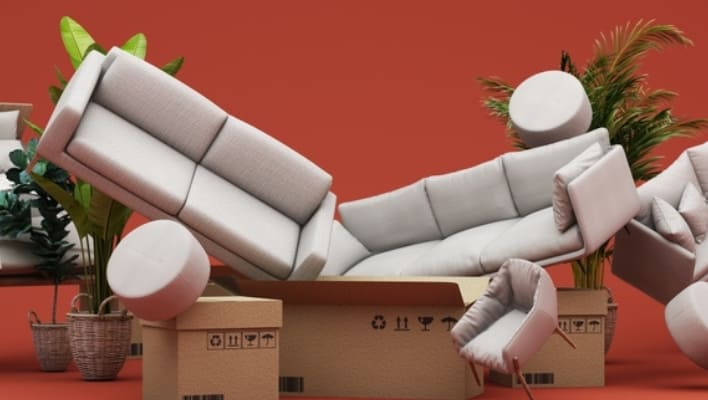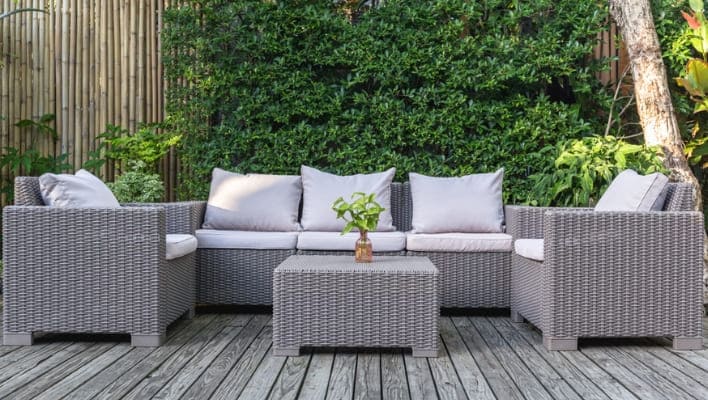Chalk paint gives the furniture a fresh and stylish makeover. But here’s the big question: How could we protect our beautiful work from wear and tear? Well, the key is to seal that chalk paint. I am a furniture painter and refinisher, so I normally take things from around my home or find budget-friendly stuff that I DIY and make into new creations.
So today is all about sealing chalk paints. In this article, I will talk about how to seal chalk paints, from sharing the 5 best methods to seal the paint and giving some of the best recommendations for better results.
Table of Contents
- Why Do We Need to Seal Chalk Paint?
- What is the best sealer for chalk paint? ( Quick Summary)
- How to seal white chalk paint without yellowing?
- Materials you’ll need:
- 5 Best Ways to Seal Chalk Paint: Tried & Tested
- 1. Wax
- 2. Polyurethane
- 3. Polycrylic
- 4. Glaze
- 5. Lacquer Varnish
- Final Thoughts
- FAQS On how to seal chalk paint
- 1. How do you seal furniture after chalk paint?
- 2. Can you put a clear coat on top of chalk paint?
- 3. How many coats of Polycrylic over chalk paint?
- 4. Can I use polyurethane over chalk paint?
- 5. Does chalk paint need sealing?
- 6. How do you permanently seal chalk paint?
- 7. How many coats of wax after chalk paint?
- Martina Hitchcock
Why Do We Need to Seal Chalk Paint?
If we briefly discuss why there is hype to seal chalk paint, it is probably for a few reasons.
First, chalk paint doesn’t alone give enough protection against wear and tear. So, when you seal it, it acts as a barrier that shields the paint surface from scratches, stains, and moisture.
Secondly, it gives extra durability and saves you time. Otherwise, you’ll have to repaint those high-traffic items if they chipped or flaked.
Finally, the topcoat deepens the colors and gives a subtle sheen that further enhances the overall appearance of the furniture piece.
“When it comes to finishing your Chalk Paint project, as Annie Sloan wisely advises, it’s crucial to consider how to protect your paintwork. After all, you wouldn’t want your dedicated efforts to be for naught!”
What is the best sealer for chalk paint? ( Quick Summary)
| Method | Best Choice for Sealing Chalk Paint | Why It’s the Best Choice ( In My Opinion) |
| Wax | Not the best choice | Wax adds a rustic charm but requires reapplication on high-traffic surfaces, longer curing time, and more maintenance. |
| Polycrylic | Best Choice | Easy to apply, water-based, faster curing, no risk of yellowing, minimal shine, and minimal maintenance, with sanding between coats for better adhesion. |
| Polyurethane | Great for durability | Very durable, easy to apply, suitable for indoor and outdoor projects, but may require a test sample due to potential drawbacks. |
| Glaze | Suitable for decorative pieces | Provides mild protection and unique coloring, easy to apply, dries quickly, but not ideal for high-wear surfaces and may require periodic reapplication. |
| Lacquer Varnish | Suitable for outdoor use | Offers durability, time-tested, but may add color and shine, requires more steps, including dilution, sanding, and multiple coats. |
How to seal white chalk paint without yellowing?
The best way to keep your white chalk paint fresh and clean is to seal it without yellowing. The following steps should be followed when using a water-based matte polycrylic such as Rust-Oleum Matte Clear.
Materials you’ll need:
- White chalk-painted piece
- Water-based matte polycrylic (e.g., Rust-Oleum Matte Clear)
- Synthetic bristle or foam brush
- Clean with a lint-free cloth
- Sandpaper (optional)
- Tack cloth (optional)
Step 1:
First prepare your chalk-painted piece by cleaning it and removing debris. If there are any rough areas or flaws on the surface, consider lightly sanding them as needed. Remove any residue from the piece by thoroughly cleaning it.
Step 2:
Do not shake the polycrylic vigorously; it can introduce bubbles if you shake it vigorously. Using a synthetic bristle or foam brush, dip it into the polycrylic and tap off any excess.
Step 3:
Apply a thin, light coat of polycrylic to the entire surface of your chalk-painted piece. It is always good practice to brush in the direction of the wood grain or paint strokes to avoid visible brush marks. Don’t overbrush, as this can cause streaks.
Step 4:
Let it dry It usually takes 2 hours for the first coat to dry according to the manufacturer’s recommendation. Don’t proceed until it has dried.
Step 5:
If you observe imperfections or brush strokes once the initial coat has dried, you can gently sand the surface using fine-grit sandpaper, such as 220-grit, to achieve a smoother texture. Following the sanding process, remove any dust using a tack cloth.”
Step 6:
Apply additional thin coats of polycrylic, usually 2-3 coats in total, waiting for each coat to dry before applying the next one. This builds a protective layer on your piece.
Step 7:
After the final coat has dried, you can optionally buff the surface with very fine steel wool or high-grit sandpaper (e.g., 400-grit) to achieve an even smoother finish. Be gentle at this step.
Step 8:
Once you’re satisfied with the finish, allow the piece to cure for at least 24 hours or as per the manufacturer’s instructions. This curing time will help the polycrylic fully harden and provide a durable finish.
Useful resource: Explore whether chalk paint provides waterproof protection for your projects. Get the facts in our detailed article.”
5 Best Ways to Seal Chalk Paint: Tried & Tested
Now, let’s talk about the five best ways that you can use to seal chalk paint.
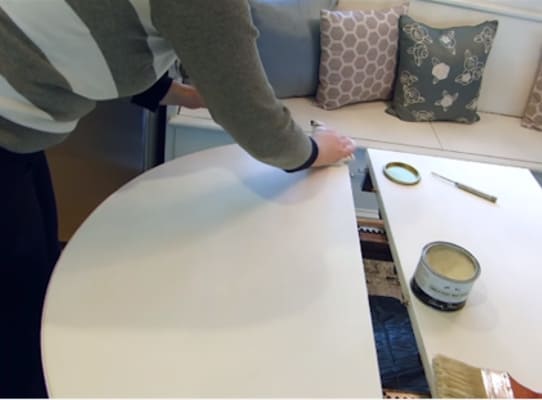
1. Wax
Wax is the most common choice for sealing chalk paint. It brings richness to chalk paints and regular paints. Applying wax is a lot like waxing a car. You apply it, buff it in, and then wipe off the excess. If you want a shinier finish, buff it more. And to get a matte look, apply and wipe.
It takes 24 hours for wax to harden enough for light use, like placing objects on the surface. However, it takes almost a week or two to fully cure.
PROS:
CONS:
My favorite Pick:
Americana Decor wax is my top pick among chalk paint sealers. It fuses smoothly with the chalk paint and creates a glossy finish. This wax is a reliable option if you want an antique look.
In case you need to remove chalk paint, here is how to do it.
2. Polyurethane
Polyurethane is usually an oil-based varnish. However, it does sometimes come in a water-based form or a spray. The application of polyurethane is quite straightforward. It’s like applying liquid plastic to a surface. It dries to form a strong plastic-like sealant.
Polyurethane is the most durable among wax, polyurethane, and polyacrylic. It is resistant to high heat as well as water.
PROS:
CONS:
My favorite Pick:
Rust-Oleum Varathane Polyurethane is our top pick. It has shorter wait periods before you can put on more coats. Its application was also smooth with no drips despite using an affordable brush.
3. Polycrylic
Polycrylic is a water-based solution used to seal chalk paint. As I said, there are some water-based polyurethanes, but polyacrylic is always water-based. It has lower levels of VOCs. So, it is safer for your health and suitable for homes with children and pets.
Although it may not match polyurethane’s durability against water and heat, it still outperforms wax. So, it is a great middle-of-the-road choice for various projects.
PROS:
CONS:
My favorite Pick:
Minwax Clear Polycrylic is my top pick among Polycrylic chalk paint sealers. What I like best is its crystal-clear finish, which dries rapidly. It is best for interior wood surfaces like woodwork, doors, furniture, or cabinets.
4. Glaze
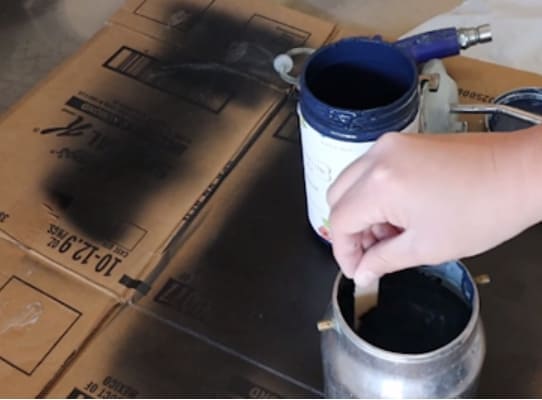
Glaze is another option to seal chalk paint. Although it is not the best choice, you can still use it for furniture finishing.
The only recommendation is to use an additional topcoat of polyurethane or Polycrylic. This is because glaze has less durability than other options on our list.
Applying glaze is a straightforward process. Just spread it onto the surface and then wipe off any excess. It typically dries relatively quickly, often overnight. So, it has speedier sealant methods.
PROS:
CONS:
My favorite Pick:
FolkArt Dragonfly Glaze is my top pick here. As a topcoat, this acrylic paint has great light-reflective pigments that give it a glossy finish. Use it on wood, metal, canvas, terra cotta etc.
5. Lacquer Varnish
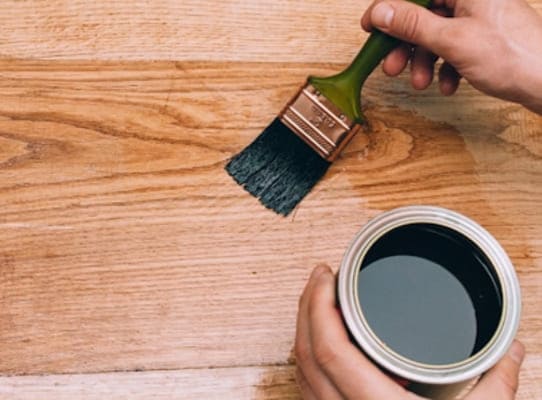
Our last chalk paint sealer is Lacquer Varnish. It is a good choice for sealing chalk paint, especially for outdoor projects where durability is a top priority. Lacquer gives a glossy or high-gloss finish to surfaces.
PROS:
CONS:
My favorite Pick:
Minwax Aerosol Lacquer Spray is my favorite pick among lacquer varnish. Although it is mostly used on wood, I’ve discovered that it can be used on glass, metal, and ceramics. I used it on a few liquor bottles, a lamp base, and a mantle clock. The results are incredible. There was no sign of peeling.
Final Thoughts
Sealing chalk paint is an essential step to ensure protection and durability. Each of the ways we discussed in this guide offers unique benefits and finishes. Now, you can choose the best option based on your project’s specific needs and desired aesthetic.
FAQS On how to seal chalk paint
1. How do you seal furniture after chalk paint?
After allowing your chalk paint to dry, you can seal it by applying a clear protective coat. Options include wax, polyurethane, or polycrylic.
2. Can you put a clear coat on top of chalk paint?
Yes, you can. Applying a clear coat like wax, polyurethane, or polycrylic helps protect and enhance the finish of your chalk paint.
3. How many coats of Polycrylic over chalk paint?
Generally, two to three coats of polycrylic are recommended over chalk paint for optimal protection and finish.
4. Can I use polyurethane over chalk paint?
Yes, polyurethane can be used to seal chalk paint. It provides durability and protection.
5. Does chalk paint need sealing?
Yes, to protect and prolong the life of your chalk paint finish, sealing is advisable.
6. How do you permanently seal chalk paint?
You can apply several layers of a transparent protective coating, such as polyurethane or polycrylic to achieve a long-lasting seal for chalk paint. Ensure each coat dries thoroughly and cures completely.
7. How many coats of wax after chalk paint?
Typically, one or two coats of wax are sufficient for sealing chalk paint, but the number can vary based on your desired level of sheen and protection.

Martina Hitchcock
Martina Hitchcock is a versatile author with expertise in different fields. As a paint sprayer expert, she has in-depth knowledge of paint spraying techniques, tools, and equipment. Martina is also an experienced home remodeler who has worked on various projects, including kitchen and bathroom renovations, flooring installations, and room additions. Her knowledge of home improvement and remodeling is extensive, and she enjoys sharing her insights and tips with readers. You can follow her on Facebook.

